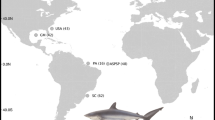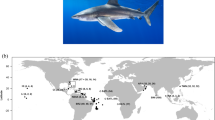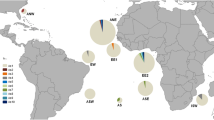Abstract
Globally, sharks are under enormous pressure from fishing efforts. One such species is the silky shark, Carcharhinus falciformis, which occurs in all the Earth’s tropical oceans and is captured in large numbers in pelagic fisheries. Regionally, the silky shark is listed as Vulnerable to Near Threatened by the International Union for the Conservation of Nature due to high levels of direct and bycatch exploitation. Despite major conservation concerns about this species, little is known about its genetic status and level of demographic or evolutionary connectivity among its regional distributions. We report a genetic assessment of silky sharks sampled across a major portion of the species’ global range. We sequenced the complete mitochondrial DNA control region from 276 individuals taken from the western Atlantic and Indo-Pacific Oceans and the Red Sea. Overall, haplotype and nucleotide diversities were relatively large (0.93 ± 0.01 and 0.61 ± 0.32 %, respectively). Nucleotide diversity in Indo-Pacific sharks, however, was significantly lower and about half that in Atlantic sharks. Strong phylogeographic partitioning occurred between ocean basins. Furthermore, shallow but significant pairwise statistical differentiation occurred among most regional samples within the Indo-Pacific, but not the western Atlantic. Overall, at least five mitochondrial DNA populations of silky sharks were identified globally. Despite historically large population sizes, silky sharks appear to be isolated on relatively small spatial scales, at least in the Indo-Pacific, indicating that conservation and management efforts will need to be exerted at relatively small scales in a pelagic and highly vagile species.


Similar content being viewed by others
References
Ahonen H, Harcourt RG, Stow AJ (2009) Nuclear and mitochondrial DNA reveals isolation of imperiled grey nurse shark populations (Carcharias taurus). Mol Ecol 18:4409–4421
Andrews KR, Karczmarski L, Au WWL, Rickards SH, Vanderlip CA, Bowen BW, Grau EG, Toonen RJ (2010) Rolling stones and stable homes: social structure, habitat diversity and population genetics of the Hawaiian spinner dolphin (Stenella longirostris). Mol Ecol 19:732–748
Aoki M, Wada K (2013) Genetic structure of the wide-ranging fiddler crab Uca crassipes in the west Pacific region. J Mar Biol Assoc UK 93:789–795
Bailey G (2009) The Red Sea, coastal landscapes, and hominin dispersals. In: Petyraglia M, Rose J (eds) The evolution of human populations in Arabia. Springer, Dordrecht
Bandelt HJ, Forster P, Röhl A (1999) Median-joining networks for inferring intraspecific phylogenies. Mol Biol Evol 16:37–48
Beebee T, Rowe G (2008) An introduction to molecular ecology, 2nd edn. Oxford University Press, Oxford
Beerkircher L, Cortes E, Shivji MS (2004) Characteristics of shark bycatch observed on pelagic longlines off the southeastern United States, 1992–2000. Mar Fish Rev 64:40–49
Benavides MT, Horn RL, Feldheim KA, Shivji MS, Clarke SC, Wintner S, Natanson L, Braccini M, Boomer JJ, Gulak SJB, Chapman DD (2011) Global phylogeography of the dusky shark, Carcharhinus obscurus: implications for fisheries management and monitoring the shark fin trade. Endanger Species Res 14:13–22
Benjamini Y, Hochberg Y (1995) Controlling the false discovery rate: a practical and powerful approach to multiple testing. J R Stat Soc Ser B 57(1):289–300
Bonfil R, Amorim A, Anderson C, Arauz R, Baum J, Clarke SC, Graha, RT, Gonzalez M, Jolón M, Kyne PM, Mancini P, Márquez F, Ruí C, Smith W (2009) Carcharhinus falciformis. Version 2014.3. The IUCN Red List of Threatened Species. http://www.iucnredlist.org/details/39370/0. Accessed 28 Oct 2014
Bonfil R (2008) The biology and ecology of the silky shark, Carcharhinus falciformis. In: Camhi MD, Pikitch EK, Babcock EA (eds) Sharks of the open ocean: biology, fisheries and conservation. Fish and aquatic resources series 13. Blackwell Publishing Ltd., UK, pp 114–127
Bowen BW, Bass AL, Rocha LA, Grant WS, Robertson DR (2001) Phylogeography of the trumpetfish, genus Aulostomus: ring species complex on a planetary scale. Evolution 55:1029–1039
Bowen BW, Muss A, Rocha LA, Grant WS (2006) Shallow mtDNA coalescence in Atlantic pygmy anglefishes (genus Centropyge) indicates a recent invasion from the Indian Ocean. J Hered 97:1–12
Bowen BW, Shanker K, Yasuda N, Malay MCD, von der Heyden S, Paulay G, Rocha LA, Selkoe KA, Barber PH, Williams ST, Lessios HA, Crandall ED, Bernardi G, Meyer CP, Carpenter KE, Toonen RJ (2014) Phylogeography unplugged: comparative surveys in the genomic era. Bull Mar Sci 90:13–46
Briggs JC, Bowen BW (2012) A realignment of marine biogeographic provinces with particular reference to fish distributions. J Biogeogr 39:12–31
Briggs JC, Bowen BW (2013) Marine shelf habitat: biogeography and evolution. J Biogeogr 40:1023–1035
Camhi MD, Valenti SV, Fordham SV, Fowler SL, Gibson C (2009) The conservation status of pelagic sharks and rays: report of the IUCN Shark Specialist Group Pelagic Shark Red List Workshop. IUCN Species Survival Commission Shark Specialist Group. Newbury, UK. x + 78p
Castro ALF, Stewart BS, Wilson SG, Hueter RE, Meekan MG, Motta PJ, Bowen BW, Karl SA (2007) Population genetic structure of Earth’s largest fish, the whale shark (Rhincodon typus). Mol Ecol 16:5183–5192
Chapman DD, Pinhal D, Shivji MS (2009) Tracking the fin trade: genetic stock identification in Western Atlantic scalloped hammerheads sharks (Sphyrna lewini). Endanger Species Res 9:221–228
Chapman DD, Simpfendorfer CA, Wiley TR, Poulakis GR, Curtis C, Tringali M, Carlson JK, Feldheim KA (2011) Genetic diversity despite population collapse in a critically endangered marine fish: the smalltooth sawfish (Pristis pectinata). J Hered 102:643–652
Chow S, Jeffs A, Miyake Y, Konishi K, Okazaki M, Suzuki N, Abdullah MF, Imai H, Wakabayasi T, Sakai M (2011) Genetic isolation between the western and eastern Pacific populations of Pronghorn spiny lobster Panulirus penicillatus. PLoS One 6:e29280. doi:10.1371/journal.pone.0029280
Clarke SC, McAllister MK, Milner-Gulland EJ, Kirkwood GP, Michielsens CGJ, Agnew DJ, Pikitch EK, Nakano H, Shivji MS (2006) Global estimates of shark catches using trade records from commercial markets. Ecol Lett 9:1115–1126
Clarke C, Lea JSE, Ormond RFG (2011) Reef-use and residency patterns of a baited population of silky sharks, Carcharhinus falciformis, in the Red Sea. Mar Freshw Res 62:668–675
Clarke SC, Harley SJ, Hoyle SD, Rice JS (2012) Population trends in Pacific oceanic sharks and the utility of regulations on shark finning. Conserv Biol 27(1):197–209
Clement M, Posada D, Crandall KA (2000) tcs: a computer program to estimate gene genealogies. Mol Ecol 9:1657–1660
Cortés E, Arocha F, Beerkircher L, Carvalho F, Domingo A, Heupel M, Holtzhausen H, Santos MN, Ribera M, Simpfendorfer C (2008) Ecological risk assessment of pelagic sharks caught in Atlantic pelagic longline fisheries. Aquat Living Resour 23:25–34
Cowman PF, Bellwood DR (2013) Vicariance across major marine biogeographic barriers: temporal concordance and the relative intensity of hard versus soft barriers. Proc R Soc B Biol Sci 280:20131541
Daly-Engel TS, Seraphin KD, Holland KN, Coffey JP, Nance HA, Toonen RT, Bowen BW (2012) Global phylogeography with mixed-marker analysis reveals male-mediated dispersal in the endangered scalloped hammerhead shark (Sphyrna lewini). PLoS One 7:e29986. doi:10.1371/journal.pone.0029986
DiBattista JD, Berumen ML, Gaither MR, Rocha LA, Eble JA, Choat JH, Craig MT, Skillings DJ, Bowen BW (2013) After continents divide: comparative phylogeography of reef fishes from the Red Sea and Indian Ocean. J Biogeogr 40:1170–1181
Duncan KM, Martin AP, Bowen BW, de Couet G (2006) Global phylogeography of the scalloped hammerhead shark (Sphyrna lewini). Mol Ecol 15:2239–2251
Eble JA, Toonen RJ, Sorenson L, Basch LB, Papastamatiou YP, Bowen BW (2011) Escaping paradise: larval export form Hawaii in an Indo-Pacific reef fish, the yellow tang Zebrasoma flavescens. Mar Ecol Prog Ser 428:245–258
Excoffier L, Laval G, Schneider S (2005) Arlequin ver. 3.0: an integrated software package for population genetics data analysis. Evol Bioinform Online 1:47–50
Feldheim KA, Gruber SH, Ashley V (2001) Population genetic structure of the lemon shark (Negaprion brevirostris) in the western Atlantic: DNA microsatellite variation. Mol Ecol 10:295–303
Ferretti F, Myers RA, Serena F, Lotze HK (2008) Loss of large predatory sharks from the Mediterranean Sea. Conserv Biol 22:952–964
Galván-Tirado C, Díaz-Jaimes P, García-de León FJ, Galván-Magaña FG, Uribe-Alcocer M (2013) Historical demography and genetic differentiation inferred from the mitochondrial DNA of the silky shark (Carcharhinus falciformis) in the Pacific Ocean. Fish Res 147:36–46
Geraghty PT, Williamson JE, Macbeth WG, Wintner SP, Harry AV, Ovenden JR, Gillings MR (2013) Population expansion and genetic structure in Carcharhinus brevipinna in the Southern Indo-Pacific. PLoS One 8(9):e75169. doi:10.1371/journal.pone.0075169
Geraghty PT, Williamson JE, Macbeth WG, Blower MJ, Johnson G, Ovenden JR, Gillings MR (2014) Genetic structure and diversity of two highly vulnerable carcharhinids in Australian waters. Endanger Species Res 24:45–60
Giles JL, Ovenden JR, Dharmadi AD, Garvilles E, Khampetch K, Manjebrayakath H, Riginos C (2014) Extensive genetic population structure in the Indo-West Pacific spot-tail shark, Carcharhinus sorrah. Bull Mar Sci 90:427–454
Habel JC, Schmitt T (2012) The burden of genetic diversity. Biol Conserv 147:270–274
Hoelzel AR, Shivji MS, Magnussen J, Francis MP (2006) Low worldwide genetic diversity in the basking shark (Cetorhinus maximus). Biol Lett 2:639–642
Hudson RR (2000) A new statistic for detecting genetic differentiation. Genetics 155:2011–2014
ICCAT (2011) Recommendation by ICCAT on the conservation of silky sharks caught in association with ICCAT fisheries, 11-08 BYC. http://www.ccsbt.org/userfiles/file/other_rfmo_measures/iccat/ICCAT_2011-08.pdf. Accessed 28 Oct 2014
Karl SA, Castro ALF, Lopez JA, Charvet P, Burgess GH (2011) Phylogeography and conservation of the bull shark (Carcharhinus leucas) inferred from mitochondrial and microsatellite DNA. Conserv Genet 12:371–382
Karl SA, Castro ALF, Garla RC (2012a) Population genetics of the nurse shark (Ginglymostoma cirratum) in the western Atlantic. Mar Biol 159:489–498
Karl SA, Toonen RJ, Grant WS, Bowen BW (2012b) Common misconceptions in molecular ecology: echoes of the modern synthesis. Mol Ecol 21:4171–4189
Keeney DB, Heist EJ (2006) Worldwide phylogeography of the blacktip shark (Carcharhinus limbatus) inferred from mitochondrial DNA reveals isolation of western Atlantic populations coupled with recent Pacific dispersal. Mol Ecol 15:3669–3679
Keeney DB, Heupel MR, Hueter RE, Heist EJ (2005) Microsatellite and mitochondrial DNA analyses of the genetic structure of blacktip shark (Carcharhinus limbatus) nurseries in the northwestern Atlantic, Gulf of Mexico, and Caribbean Sea. Mol Ecol 14:1911–1923
Kohler NE, Turner PA (2001) Shark tagging: a review of conventional methods and studies. Environ Biol Fishes 60:191–223
Kohler NE, Casey JG, Turner PA (1998) NMFS cooperative shark tagging program, 1962–1993: an atlas of shark tag and recapture data. Mar Fish Rev 60:1–87
Librado P, Rozas J (2009) dnasp v5: a software for comprehensive analysis of DNA polymorphism data. Bioinformatics 25:1451–1452
Marko PB (2002) Fossil calibration of molecular clocks and the divergence times of geminate species pairs separated by the Isthmus of Panama. Mol Biol Evol 19:2005–2021
MigraMar (2011) Silky shark tagged in Galapagos is detected at Clipperton Atoll. http://migramar.org/hi/home/silky-shark-tagged-in-galapagos-is-detected-at-clipperton-atoll/. Accessed 28 Oct 2014
Nance HA, Klimley P, Galván-Magan M-OJ, Marko PB (2011) Demographic processes underlying subtle patterns of population structure in the scalloped hammerhead shark, Sphyrna lewini. PLoS One 6:e21459. doi:10.1371/journal.pone.0021459
Nei M, Maruyama T, Chakraborty R (1975) The bottleneck effect and genetic variability in populations. Evolution 29:1–10
Pérez-Jiménez JC (2014) Historical records reveal potential extirpation of four hammerhead sharks (Sphyrna spp.) in Mexican Pacific waters. Rev Fish Biol Fish 24:671–683
Pinsky ML, Palumbi SR (2014) Meta-analysis reveals lower genetic diversity in overfished populations. Mol Ecol 23:29–39
Portnoy DS, McDowell JR, Heist EJ, Musick JA, Graves JA (2010) World phylogeography and male-mediated gene flow in the sandbar shark, Carcharhinus plumbeus. Mol Ecol 19:1994–2010
Reece JS, Bowen BW, Smith DG, Larson AF (2010) Molecular phylogenetics of moray eels (Muraenidae) demonstrates multiple origins of shell-crushing jaw (Gymnomuraena, Echidna) and multiple colonization of the Atlantic Ocean. Mol Phylogenet Evol 57:829–835
Richards VP, Henning M, Witzell W, Shivji MS (2009) Species delineation and evolutionary history of the globally distributed spotted eagle ray (Aetobatus narinari). J Hered 100:273–283
Roberts MA, Schwartz TS, Karl SA (2004) Global population genetic structure and male-mediated gene flow in the green sea turtle (Chelonia mydas): analysis of microsatellite loci. Genetics 166:1857–1870
Rocha LA, Robertson DR, Roman J, Bowen BW (2005a) Ecological speciation in tropical reef fishes. Proc R Soc B Biol Sci 272:573–579
Rocha LA, Robertson DR, Rocha CR, Van Tassell JL, Craig MT, Bowen BW (2005b) Recent invasion of the tropical Atlantic by an Indo-Pacific coral reef fish. Mol Ecol 14:3921–3928
Sánchez-de Ita JA, Quiñónez-Velázquez C, Galván-Magaña F, Bocanegra-Castillo N, Félix-Uraga R (2011) Age and growth of the silky shark Carcharhinus falciformis from the west coast of Baja California Sur, Mexico. J App Ichthyol 27:20–24
Schmidt JV, Schmidt CL, Ozer F, Ernst RE, Feldheim KA, Ashley M, Levine M (2009) Low genetic differentiation across three major ocean populations of the Whale shark, Rhincodon typus. PLoS One 4:e4988. doi:10.1371/journal.pone.0004988
Schrey AW, Heist EJ (2003) Microsatellite analysis of population structure in the shortfin mako (Isurus oxyrinchus). Can J Fish Aquat Sci 60:670–675
Schultz JK, Feldehim K, Gruber SH, Ashley MV, McGovern TM, Bowen BW (2008) Global phylogeography and seascape genetics of the lemon sharks (genus Negaprion). Mol Ecol 17:5336–5348
Shivji MS (2010) DNA forensic applications in shark management and conservation. In: Carrier JC, Heithaus MR, Musick JA (eds) Sharks and their relatives II: biodiversity, adaptive physiology, and conservation. CRC Press, Boca Raton, pp 593–610
Siddall M, Rohling EJ, Almogi-Labin A, Hemleben C, Meischner D, Schmelzer I, Smeed DA (2003) Sea-level fluctuations during the last glacial cycle. Nature 423:853–858
Sodré D, Rodrigues-Filho LFS, Souza RFC, Rêgo PS, Schneider H, Sampaio I, Vallinoto M (2012) Inclusion of South American samples reveals new population structuring of the blacktip shark (Carcharhinus limbatus) in the western Atlantic. Genet Mol Biol 35:752–760
Villesen P (2007) FaBox: an online toolbox for fasta sequences. Mol Ecol Notes 7(6):965–968
Ward-Paige CA, Mora C, Lotze HK, Pattengill-Semmens C, McClenachan L, Arias-Castro E, Myers RA (2010) Large-scale absence of sharks on reefs in the greater-Caribbean: a footprint of human pressures. PLoS One 5:e11968. doi:10.1371/journal.pone.0011968
Watson JT, Essington TE, Lennert-Cody CE, Hall MA (2008) Trade-offs in the design of fishery closures: management of silky shark bycatch in the eastern Pacific ocean tuna fishery. Conserv Biol 23:626–635
Whitney NM, Robbins WD, Schultz JK, Bowen BW, Holland KN (2012) Oceanic dispersal in a sedentary reef shark (Triaenodon obesus): genetic evidence for extensive connectivity without a pelagic larval stage. J Biogeogr 39:1144–1156
Yokota L, Lessa RP (2006) A nursery area for sharks and rays in northeastern Brazil. Environ Biol Fishes 75:349–360
Acknowledgments
Funding for this study was provided by the Save Our Seas Foundation, Save Our Seas Shark Research Center, Danah Divers, the Guy Harvey Ocean Foundation and Nova Southeastern University. We thank S. Gulak and D. Bethea (NMFS Panama City Laboratory), and D. McCauley and C. Wilson for contributing shark samples. We are grateful to C. Galván-Tirado and colleagues for providing additional silky shark sequences from their paper, which allowed us to extend our shark assessment to the EP. We specially thank the founder of Save Our Seas Foundation for his vision, passion and efforts in supporting shark research to help understand, preserve and protect these dwindling species around the world.
Author information
Authors and Affiliations
Corresponding author
Additional information
Communicated by T. Reusch.
Electronic supplementary material
Below is the link to the electronic supplementary material.
Rights and permissions
About this article
Cite this article
Clarke, C.R., Karl, S.A., Horn, R.L. et al. Global mitochondrial DNA phylogeography and population structure of the silky shark, Carcharhinus falciformis . Mar Biol 162, 945–955 (2015). https://doi.org/10.1007/s00227-015-2636-6
Received:
Accepted:
Published:
Issue Date:
DOI: https://doi.org/10.1007/s00227-015-2636-6




